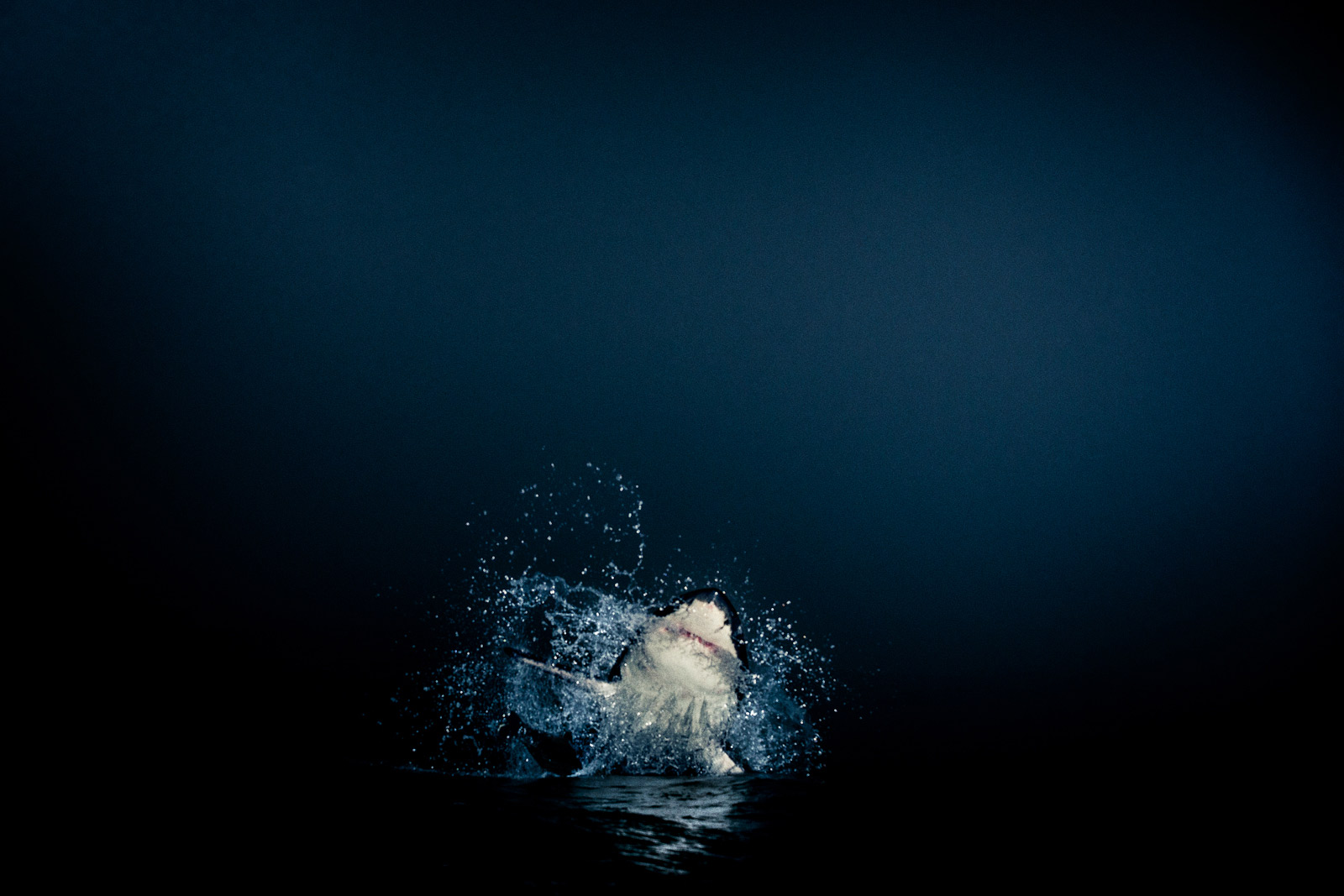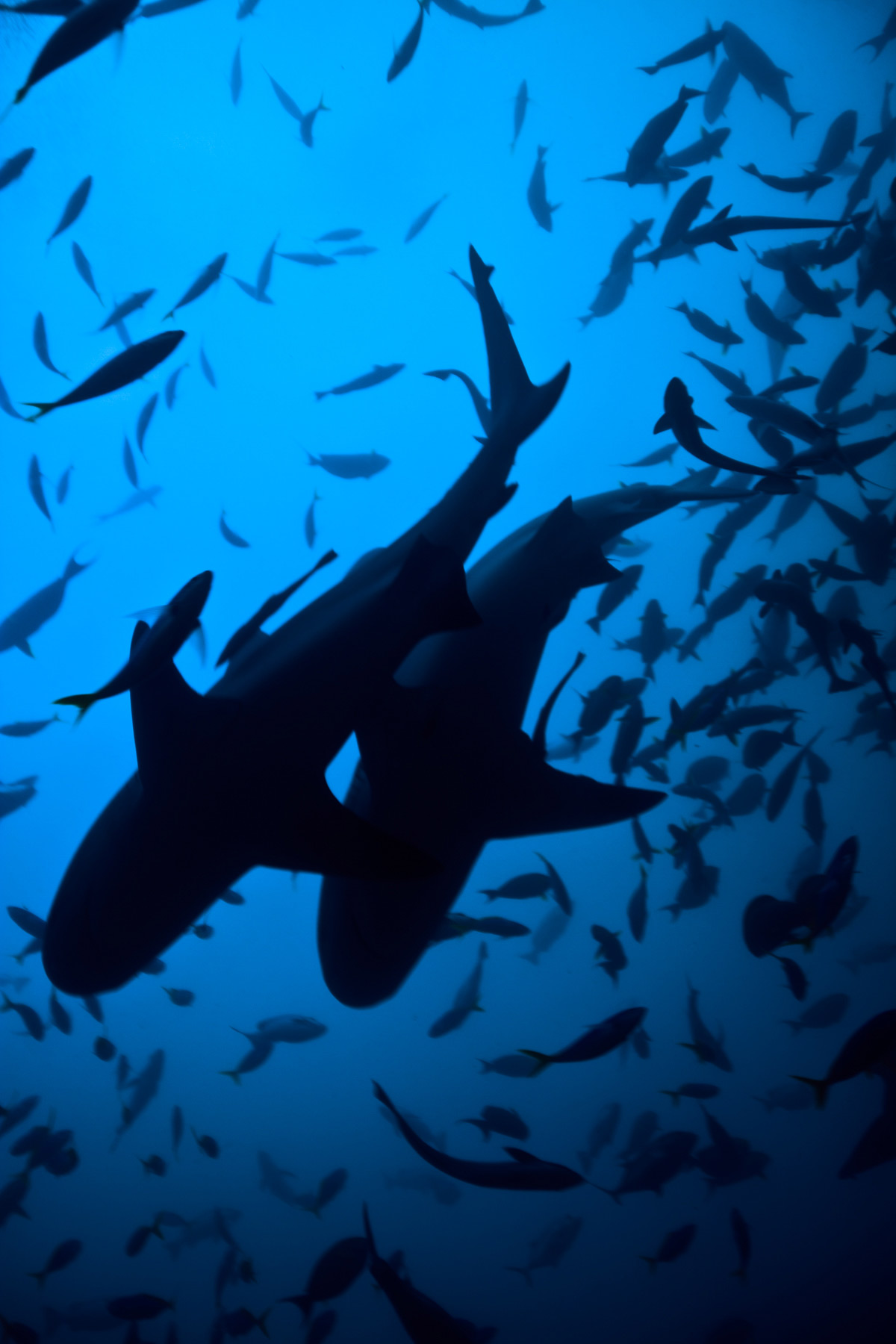Interview: Photographer Michael Muller
How he takes his mesmerizing, intimate shark portraits (hint: get out of the cage)

LA-based photographer Michael Muller has captured celebrities (including Rihanna for her album cover Unapologetic) to mutants and superheroes (the movie posters for “X-Men Apocalypse” and “Captain America: Civil War” to name a few), but the most fascinating subject that’s challenged him continuously over the past decade lives far from the hills of Hollywood. Since 2007, Muller has been swimming among the sharks, shooting in a completely new light. We mean this quite literally, as he custom-built a patented 1200-watt waterproof strobe lighting system to bring underwater. Differing from the typical “captured-in-natural-habitat” style often seen in dedicated wildlife magazines, Muller’s intimate, mesmerizing shark portraits—ranging from the mighty great white to oceanic whitetips and scalloped hammerheads—convey an energy and wonder that has you wanting to learn more.
Importantly, Muller’s role is beyond that of subaquatic paparazzi; his driving mission is to change attitudes regarding these wrongly stereotyped creatures. Within his new photo book for TASCHEN, “Sharks: Face-to-Face with the Ocean’s Endangered Predator,” stunning color and black-and-white photos of the majestic animal await. But he’s also included bloody documentary photos he took of shark finning and educational essays on the species, their plight (sharks have been made vulnerable by fishing, habitat loss, climate change and more—but only the rare shark attack seems to make headlines) and conservation efforts in the most visually engaging way. Check out our interview below to learn more about why Muller was so determined to take photos outside of a shark cage, how he brings his light studio 90 feet underwater, and the difference between shooting great whites and celebrities.

Can you detail your long-term transition into becoming a near cage-free shark photographer?
Well, 10 years ago I went on my first great white shark trip. It was on the Nautilus Explorer and I was joined by 12 other strangers on a trip to Guadalupe, Mexico. That was the first time I had seen a shark in the wild. They had cages on the back of the boat as well as a cage they dropped to 20-30 feet. From the moment I set eyes on that shark I had a massive desire to get out of that cage and interact with the animal. I felt claustrophobic, but more than that, I could see how intelligent the animal was and that it wasn’t there for me but instead it wanted the tuna we were using to chum with. It would look at us with skepticism as it would go after its primary food source. At the same time I am looking at an 18 foot long animal with rows of sharp teeth. It was like an SUV and a Fiat tied together passing you.

The size, and more impressive, the girth of these animals cannot truly be translated until you see it in real time. No show or photo I’ve ever seen really justifies how big they are. So from that trip I did not use a cage with any other shark species such as bull sharks, hammerheads, tiger sharks, blacktip, oceanic whitetips and so on. I spent hundreds of hours underwater learning their behavior from my mentor and shark specialist Morne Hardenberg who runs Shark Explorers out of South Africa. He taught me most of what I know. As much as we are not on their menu, they are still wild animals capable of doing tremendous damage to a human if one’s not careful or gets cocky. So I always try and remain humble and have the utmost respect for these animals and their domain that I’m entering.

Why was it important for you to shoot outside of a cage?
It was important for me to face my fears, but more important, it was a primary objective to change people’s perceptions. Sure I can say, “My shark guy uses no cage” and people would say well of course, he’s a shark guy. But when someone like myself—who is not a shark specialist—or a famous actor or athlete, or my 11-year-old daughter can swim with sharks not hiding behind a cage, it impacts people in a much more profound way.

What’s the deepest you’ve ever gone underwater? What is the process involved for bringing the light and camera equipment down there?
The deepest I’ve gone is 130 feet on a 4 mile drift dive in the sea of Cortez. It was one of the coolest dives I’ve done—the bottom is racing by you as you feel like a jet plane and you’re on the edge of a cliff that drops off into 3000 feet of a dark abyss. When people go past certain depths, depending on the person they get “narc’d” which is a euphoric-type feeling when the lack of oxygen and gasses start affecting your head. And so I’m racing along this cliff side and you have to be very careful cause you can drop 30 feet in a matter of seconds and not notice. So I’m flying along saying to myself “THIS IS AMAZING, I WANT TO STAY DOWN HERE FOREVER” and as I’m thinking this, a little voice says, “Check your depth or die” and I’m like, “OH I’m at 145 feet.” I get back over the cliff quick to see a turtle come straight down from the surface in a matter of seconds and join us. It was amazing.
The deepest we brought my studio was 90 feet. That was a monumental task. Surging seas and current pulling the boat where the batteries are held which in turn pulls the 140 foot cables that have my strobe lights attached on the other end with an assistant of mine holding them was a logistical nightmare. We had to tie off the boat on a rock at the reef then rig rope down that we clipped the cables to. You just understand no one has ever done this before, so there is no one saying “This is how you do it.” So each dive, each trip was a new challenge we had to overcome. That is what makes it all worthwhile, when you face those walls and it looks impossible and being told it is impossible and then somehow, some way, someone has an idea and it works and we do it. There is a tremendous sense of accomplishment in those moments. It’s funny because I have forgotten many of those moments and [discussing] this brings them all flooding back into my consciousness and fills me with joy and pride in my team.

Have you shot most of your dream shark scenarios? What else is left on the list now that you’ve got, for examples, rare shots of a shark breaching at night?
Most of them. There are several more, and let’s say I shoot those—well then my mind will find several others cause that’s how I’m wired. Set goals, visualize them and then take steps toward them, achieve goals and then enjoy the fruits of your labor—and after the dust settles, set new ones.
As far as sharks go I am very content with what I achieved in the decade of shooting them. I have close to half a million images and am very content with what I accomplished. Will I stop shooting sharks? Never. Will I put as much time, money and resources as I’ve been doing for 10 years? No. Have I set forth on a new project? Yes. Can I tell you the details? No. When I’m doing a project I don’t like to talk about it. I am the type that likes to show you when I’m done. For me, talk is cheap—they are just words and ideas. I like to manifest those ideas and then show people those manifestations.

Posters for X-Men Apocalypse are everywhere: can you even compare shooting mutants and film actors with sharks?
Yeah, it’s cool to see X-Men and across the street Captain America: Civil War and on the corner, HBO’s “All the Way”—I shot all 3 and they are all up now at same time. I don’t like to compare my work. I enjoy seeing that side of my photography up and being used and I am so grateful for that work because that work funded my shark project. I would have never been able to pay for all that went into the sharks had I not been shooting all that commercial work. Now I will say the sense of fulfillment I get from the shark project is much different than any other shoot. It feels much bigger than me. It’s all about our planet and extinction and trying to save something I hold so dear and keeping things I want my children and their children to have the ability to see. If we collectively do not start making drastic changes soon, there won’t be any sharks left to see. What I have noticed lately is the animal [organizations] are more concerned with climate change now than animals because if we stay that course, it won’t matter because nothing will be left.
I know it’s not a fun topic but that’s the problem: we all prefer the warm blanket of denial and our hot Starbucks than talk about climate change and the world falling into a place where no one wants to think about.
Does shooting people become incredibly easy once you’ve wrangled with the deep blue ocean?
People are never “easy” to shoot because no one enjoys their photo being taken. All their insecurities rise to the surface and it’s a very vulnerable position to be in. I will say none of them scare me, they can try to intimidate me—but yes, after facing a great white head on weeks or days before, I sorta laugh to myself at their attempt to cover their inferiority with a big bark.

“Sharks, Face-to-Face with the Ocean’s Endangered Predator” is now available from TASCHEN (with Collector’s and Art Edition options, with the former packaged in a distressed shark cage) and Amazon. Over 50 of his prints are on view at TASCHEN Gallery in LA until mid-June (tentatively), as well as online at TASCHEN. A percentage of print sales will benefit Wild Aid, Shark Spotters, Sea Shepherd, and EarthEcho.
Book image by Cool Hunting, all other images ©Michael Muller / Taschen / Image distribution CPi Syndication












